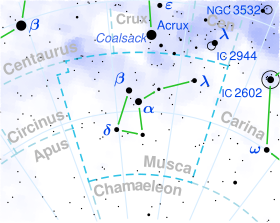S Muscae
| Observation data Epoch J2000 Equinox J2000 | ||
|---|---|---|
| Constellation | Musca
| |
| Right ascension | 12h 12m 47.01834s[1] | |
| Declination | −70° 09′ 06.4363″[1] | |
| Apparent magnitude (V) | 6.394[2] (5.89 - 6.49[3]) | |
| Characteristics | ||
| Spectral type | F6Ib (F6-G0[3]) + B5V[4] | |
| U−B color index | +0.66[5] | |
| B−V color index | +1.00[5] | |
| Variable type | δ Cepheid[3] | |
| Absolute magnitude (MV) | −4.01[7] | |
Semi-amplitude (K1)(primary) | 14.7 ± 0.2 km/s | |
| Details | ||
| Mass | 6.2[7] M☉ | |
| Radius | 65.1[2] R☉ | |
| Luminosity | 3,467[7] L☉ | |
| Metallicity | +0.18[9] | |
| companion | ||
| Mass | 5.3[7] M☉ | |
| Temperature | 17,000[10] K | |
AAVSO 1207-69 | ||
| Database references | ||
| SIMBAD | data | |
S Muscae is a
Musca
about 2,600 light years away.

S Muscae is a yellow supergiant ranging between spectral types F6Ib and G0Ib and magnitudes 5.89 to 6.49 over a period of 9.66 days.[3] It is a luminous star around six times as massive as the Sun and 65.1 times the radius of the Sun. It is a binary star with a blue-white main sequence star companion likely to be of spectral type B3V to B5V with a mass of just over five solar masses,[12] one of the hottest and brightest companions of a Cepheid known. The two stars orbit each other every 505 days.[13]
S Muscae has been found to lie within the faint star cluster ASCC 69.[14]
References
- ^ S2CID 18759600.
- ^ Bibcode:2005AcA....55..247M.
- ^ Bibcode:2009yCat....102025S.
- Bibcode:2014yCat....1.2023S.
- ^ Bibcode:2002yCat.2237....0D.
- S2CID 119387088.
- ^ S2CID 34133110.
- .
- S2CID 18283579.
- S2CID 119020617.
- ^ "MAST: Barbara A. Mikulski Archive for Space Telescopes". Space Telescope Science Institute. Retrieved 8 December 2021.
- doi:10.1086/303725.
- doi:10.1086/132668.
- S2CID 119113620.

